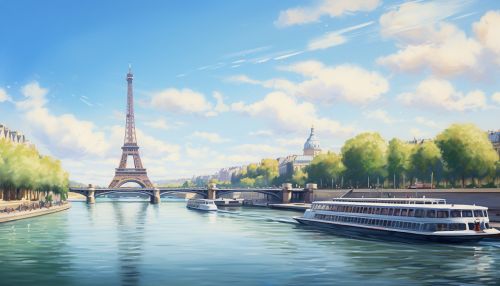Seine
Geography
The Seine is a major river and commercial waterway within the regions of Île-de-France and Haute-Normandie in France. It spans a length of approximately 777 kilometers, making it the second-longest river flowing completely in France, after the Loire. Its drainage basin covers an area of about 79,000 square kilometers.


The Seine originates from Source-Seine, about 30 kilometers northwest of Dijon in northeastern France. The river then flows in a northwesterly direction through Paris before emptying into the English Channel at Le Havre. The Seine's course is divided into five parts: the Petite Seine, from its sources to Montereau; the Haute Seine, from Montereau to Paris; the Traversée de Paris, the passage through Paris; the Basse Seine, from Paris to Rouen; and the Maritime Seine, from Rouen to the sea.
Hydrology
The Seine is a 'mixed river' but is classified as rain-fed because the percentage of direct runoff is slightly higher than that of groundwater flow. The Seine's flow varies greatly over the seasons, with the river's water levels typically peaking in winter and dropping in summer. The river is navigable by ocean-going vessels as far as Rouen, 120 kilometers from the sea.
History
The Seine has been an integral part of Parisian life and French history for centuries. It was a critical transportation route during the Roman period. In the Middle Ages, the river served as a major trade route, transporting goods such as wine, wood, and agricultural products. The Seine also played a significant role during the World War II, acting as a defensive barrier during the Battle of Paris in 1944.
Ecology
The Seine's water quality has been a concern for decades. Efforts to improve water quality began in the 1990s with the implementation of major wastewater treatment plants around Paris. Today, the river hosts a variety of fish species, including trout, carp, and pike, and is a vital habitat for numerous bird species.
Economy
The Seine is a vital commercial waterway, with numerous ports along its course. The ports of Rouen, Le Havre, and Paris are significant for the reception of wheat, oil, and containers. The river also supports many river cruise companies that offer tours of various lengths, catering to the tourism industry.
Cultural Significance
The Seine has been an inspiration for many artists, writers, and musicians. It is featured in paintings by artists such as Claude Monet and Pierre-Auguste Renoir. The river is also the subject of many songs and is frequently referenced in literature.
